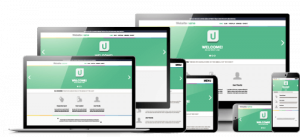Don’t be hasty when it comes to a redesign for your website. Whether we’re talking about an online store, blog, or presentation website, you need to have a clear image of how it performs in the present. This applies regardless of whether we are discussing a minor or a major redesign.
A thorough analysis is needed to get a clear view of the strengths or weaknesses of the current design. This way, you will avoid making mistakes that will cost both time and money. Usually, your designer or web design agency will show you the weaknesses (where the current design can be improved) and the strengths. Of course, some of the analysis can be handled by you, as the owner / manager of that website.
Keep in mind that we are not just talking about the look. A good-looking design is not enough. Not in 2018. All redesigns have to be crafted and thought from the customer’s point of view. We include here customers’ interaction with the website and the actions that we want them to do, and how easy they can find everything they need (or we want them to need). For example, the route to conversion must be clearly highlighted with a legible call-to-action. (here goes the correct arrangement of the page, the use of colors in a correct and coherent way, appealing texts, and so on.)
Basically, you want to improve the user experience, not just change color.
If you’re doing a redesign without updating the content or without caring about the user experience and the way clients are interacting with your store or site, the chances that you are heading for a fiasco are huge.
In order to make a correct redesign, we need data. The website must have some traffic (ideally from various sources, not just PPC) in order to make an analysis. A redesign for a store with ten visits a day is more of a guess than a well-thought process and series of actions.
In short, a qualitative redesign is a redesign that improves user experience with quality content and a coherent layout design that highlights it in an intuitive way.
When and why you may think about a redesign?
- The content on the site is qualitative and sufficient, but the interface is outdated. Changes made by redesign are intended to improve user experience and make your content (products, articles, and so on) more visible. This will make your website easier to navigate.
- Specific cases where a particular problem is requiring some improvements. For example, you analyze how your users behave on your store and you notice that they get lost at a certain point. That is the point when you lose a lot of traffic/orders or you have a high bounce rate;
- None of the above. Everything is OK. Even if the content is qualitative and sufficient, and there are no functionality issues, you may want to optimize your conversion rate. A redesign can also be done to optimize a page or more for conversions – some might refer to this scenario as conversion rate optimization.
What do you expect from a redesign?
If you’re already thinking about a redesign for your company website or online store, you probably already have some goals or expectations in mind.
As I wrote at the beginning of this article, just a good-looking design does not guarantee results. However, even if you don’t know exactly what are the problems that users are experiencing while browsing on your store or site, you know what results you expect from a redesign.
In this case, you will probably need an agency or a web designer. Whatever the case, do not forget to set one or more realistic goals and constantly keep track of the results. Objectives vary on a case-by-case basis and also do solutions.
- increasing conversions / orders by 30%;
- multiple subscriptions to newsletter;
- more products sold from a certain category from your store;
- bounce rate reduction on mobile devices
- reducing the number of users leaving at a certain point from the store;
- reducing the number of abandoned shopping carts;
- Increasing time spent on site
- correct display on any mobile device (responsive);
- reducing the number of calls/questions to the support department;
- and the list goes on.
Researching UX data
UX = user experience
A correct redesign is based on a careful study of the actual users’ experience on your online store or website.
Why?
Because you find out more about your website visitors and the way they interact with the platform.
At the same time, you may find the weaknesses of the store or site. With this data, we eliminate the “guesswork”. By establishing a data-driven pattern, it is possible to work more effectively on the present issues. It is not recommended to rely on ideas starting with ‘I believe’, “probably” or “I like it”. Every adjustment, especially if it is a major one, needs to be backed up by data and carefully researched.
What you may think is logical, because you are used to the interface, is likely to be difficult for a fist time visitor.
In addition to tools like Google Analytics, we also have other ways to get the right data about a site’s design. You can use a heat map (preferably with mouse and click tracking), one or more A / B tests, ‘user testing’, and more.
Which of the above tools should be used? It depends on the problems you are facing, on your goals, but also on how much you want to invest in the research phase of the redesign process.
Now it would be a good time to recall (although it would be ideal to write down) what complaints or concerns your customers and visitors had. Example: Something like “I have not managed to place the order”, “I can’t find the shopping cart” could give you some tracks on possible problems, especially if you also have other data that suggests a problem in the accessibility of the shopping cart button.
Don’t place aspect before functionalities
Attractive design can be a decisive factor when the user decides to stay or leave the site or store, but the aspect and placement of elements should not overwhelm the experience of potential customers. All elements that are requiring attention or action by the user must be clear and simple. (example: calls to action “contact us now”, “order now”, etc.)
Obtain a more efficient user experience in order to help customers to place orders or to make a simple conversion. Sometimes even that extra click makes the difference.
Responsive / Mobile friendly
Hi. This is 2018. Almost everyone navigated at least twice on their smartphone besides their notebook or PC. A mobile-friendly store or website is a must.
Your website needs to be responsive if you want to give users a pleasant experience on any device. Your company website must be easy to use on any modern device.
Users search for products or information when they are not near a laptop or PC. That’s why visitors will come to your site on a smartphone or tablet, and they expect the site along with the content on it to be ready for them too.
Consider and make specific optimizations depending on the device. Perhaps a site that looks good on the desktop is also displayed correctly on a 5-inch screen. But is it effectively displayed? Maybe some items can be adjusted specifically for these devices to make it easier for the user to place an order or subscribe to a newsletter.
We approach these things in a mobile-first mindset. In the current age, I think having a well designed, easy to use and fast store or website for the mobile should be the number one priority. Most traffic nowadays comes from mobile.
SEO – search engine optimization
Why are we talking about SEO in an article about redesign and user experience? Because the visits of a well-designed site are often based on organic traffic (SEO).
In the quest for optimization of the user experience or design, you should not affect your website content, and we refer here to the quality and quantity of the content.
There are some connections between design optimization and SEO. The most obvious example would be an online store menu. If the menu and the product categories are not logical and properly structured, you can also lose organic traffic due to how search engines analyze and understand what’s in your online store + the menu is difficult to use by potential customers.
Branding – Do not alter your image for a trend
Trends are always changing, and maybe this month is trending a specific type of slider but keep in mind that you shouldn’t take it too far from your brand identity. The same goes for a website redesign. Make sure you still keep the brand image, which is already well-placed in the customers’ minds. The last thing you want from a redesign is to create confusion among customers.
Be coherent and respect the brand guidelines, its mission, and its values. A redesign is not a re-branding!
Let’s not forget about the defining elements of a brand, elements that are making a brand recognizable: colors, font, and so on. If you already have a brand manual, all these aspects and the necessary guidelines are found within it and must be respected.
A website redesign should strengthen the brand image.
How do you test the results of a redesign?
After the redesign is up and running, tests are being done to see how it affects user experience. The tests differ depending on what we want to check. We can check just one item, one page, or the whole website. For example: if we want to check a button, we’ll run an A / B test.
Make sure you grant enough time and volume of traffic in order to validate or invalidate the effectiveness of a design change. Testing, analyzing, and waiting takes time. These methods will give reliable results that you can trust and will eliminate any doubts (the guess factor).
Monitor and optimize constantly
Why do you constantly need to check the user experience on your website and make adjustments or test constantly? Because your website or online store can become more efficient and will have a better UX.
When the redesign is up and running, you have just begun.
Perhaps you initially believed that a certain change would have a major impact on the user experience, and after testing, you’ll see that it doesn’t have the expected impact or might appear unexpected surprises because of it.
We recommend to do a research (UX research) and analyze how users interact with the new design. You can do that by collecting the data provided by the heat-mapping service and the metrics tracked by you (time spent on site/bounce rate and so on)
Why is this happening?
People are different, and everyone interacts differently with the site. All you have to do is constantly monitor and improve.
Pre-existing users who were used to the previous interface will have to get used to the new interface.
Conclusions
We could say optimization never ends for an ever-evolving business.
A website based on the results of a thorough research and on the principles of functionality and user experience is an extremely powerful tool for your business.
Redesigning a website is more than changing some colors or elements. It is a process from which we can get more results and conversions for an existing website, and it involves several stages – each as important as the other.
If this article helped you to understand what a redesign means or gave you some good tips to take active steps towards a successful redesign, do not forget to give it a share on your favorite social networking site!
It might help other online store owners, websites, or blogs 🙂

